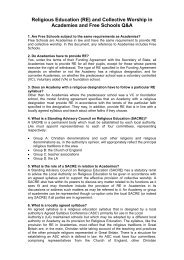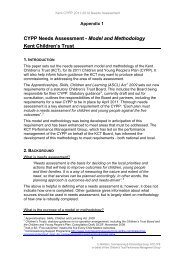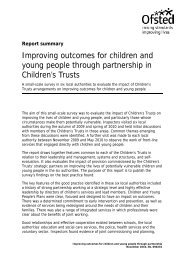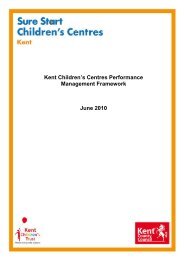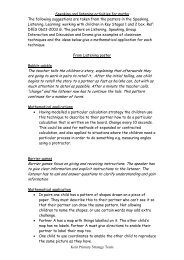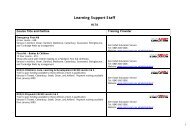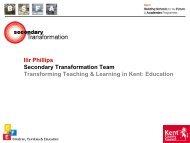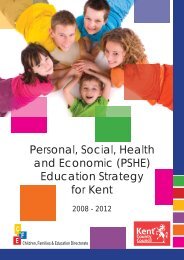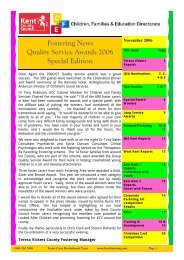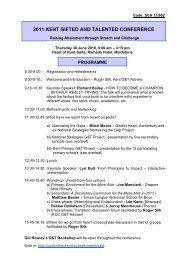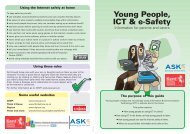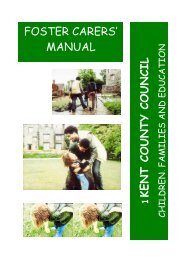Key Stage 1 - Kent Trust Web
Key Stage 1 - Kent Trust Web
Key Stage 1 - Kent Trust Web
Create successful ePaper yourself
Turn your PDF publications into a flip-book with our unique Google optimized e-Paper software.
Level 4<br />
Pupils use their understanding of place value to multiply and divide whole numbers by 10 or 100. In<br />
solving number problems, pupils use a range of mental methods of computation with the four operations,<br />
including mental recall of multiplication facts up to 10 x 10 and quick derivation of corresponding division<br />
facts. They use efficient written methods of addition and subtraction and of short multiplication and<br />
division. They add and subtract decimals to two places and order decimals to three places. In solving<br />
problems with or without a calculator, pupils check the reasonableness of their results by reference to<br />
their knowledge of the context or to the size of the numbers. They recognise approximate proportions of<br />
a whole and use simple fractions and percentages to describe these. Pupils recognise and describe<br />
number patterns, and relationships including multiple, factor and square. They begin to use simple<br />
formulae expressed in words. Pupils use and interpret coordinates in the first quadrant.<br />
Level 5<br />
Pupils use their understanding of place value to multiply and divide whole numbers and decimals by 10,<br />
100 and 1000. They order, add and subtract negative numbers in context. They use all four operations<br />
with decimals to two places. They reduce a fraction to its simplest form by cancelling common factors<br />
and solve simple problems involving ratio and direct proportion. They calculate fractional or percentage<br />
parts of quantities and measurements, using a calculator where appropriate. Pupils understand and use<br />
an appropriate non-calculator method for solving problems that involve multiplying and dividing any<br />
three-digit number by any two-digit number. They check their solutions by applying inverse operations or<br />
estimating using approximations. They construct, express in symbolic form, and use simple formulae<br />
involving one or two operations. They use brackets appropriately. Pupils use and interpret coordinates in<br />
all four quadrants.<br />
Level 6<br />
Pupils order and approximate decimals when solving numerical problems and equations [for example,<br />
x3 + x = 20], using trial and improvement methods. Pupils are aware of which number to consider as 100<br />
per cent, or a whole, in problems involving comparisons, and use this to evaluate one number as a<br />
fraction or percentage of another. They understand and use the equivalences between fractions,<br />
decimals and percentages, and calculate using ratios in appropriate situations. They add and subtract<br />
fractions by writing them with a common denominator. When exploring number sequences, pupils find<br />
and describe in words the rule for the next term or nth term of a sequence where the rule is linear. They<br />
formulate and solve linear equations with whole-number coefficients. They represent mappings<br />
expressed algebraically, and use Cartesian coordinates for graphical representation interpreting general<br />
features.<br />
Attainment target 3: Shape, space and measure:<br />
Level 2<br />
Pupils use mathematical names for common 3D and 2D shapes and describe their properties, including<br />
numbers of sides and corners. They distinguish between straight and turning movements, understand<br />
angle as a measurement of turn, and recognise right angles in turns. They begin to use everyday nonstandard<br />
and standard units to measure length and mass.<br />
Level 3<br />
Pupils classify 3D and 2D shapes in various ways using mathematical properties such as reflective<br />
symmetry for 2D shapes. They use non-standard units, standard metric units of length, capacity and<br />
mass, and standard units of time, in a range of contexts.<br />
Level 4<br />
Pupils make 3D mathematical models by linking given faces or edges, draw common 2D shapes in<br />
different orientations on grids. They reflect simple shapes in a mirror line. They choose and use<br />
appropriate units and instruments, interpreting, with appropriate accuracy, numbers on a range of<br />
measuring instruments. They find perimeters of simple shapes and find areas by counting squares.<br />
35



